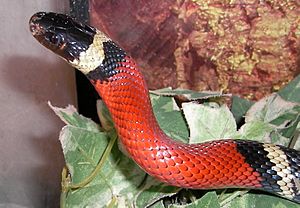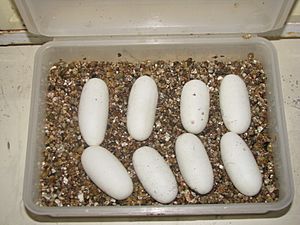Sinaloan milk snake facts for kids
Quick facts for kids Sinaloan milk snake |
|
|---|---|
 |
|
| Sinaloan milk snake | |
| Scientific classification |
|
| Kingdom: | Animalia |
| Phylum: | Chordata |
| Class: | Reptilia |
| Order: | Squamata |
| Suborder: | Serpentes |
| Family: | Colubridae |
| Genus: | Lampropeltis |
| Species: | |
| Subspecies: |
L. t. sinaloae
|
| Trinomial name | |
| Lampropeltis triangulum sinaloae (K.L. Williams, 1978)
|
|
The Sinaloan milk snake (scientific name: Lampropeltis triangulum sinaloae) is a type of snake that lays eggs. It is not venomous, meaning it's not poisonous. This snake is one of the most popular kinds of milk snakes raised by people. It's usually a calm snake and rarely bites.
Unlike some other milk snakes, the Sinaloan milk snake doesn't actually produce 'milk'. But if you handle it, it might release a strong-smelling liquid from its body as a warning. These snakes live in the dry, rocky areas of southwest Sonora, Sinaloa, and southwest Chihuahua in Mexico.
Contents
What Does It Look Like?
The Sinaloan milk snake is mostly bright red with clear black rings. Inside these black rings, there are thinner cream-colored, white, or sometimes light yellow bands. The red bands are much wider than the black ones, which helps tell this snake apart from other milk snakes.
Its head is black, with a cream-colored band right behind its eyes, going across the top of its head. The snake's belly is a creamy white color. Adult Sinaloan milk snakes can grow to be about 120 centimeters (about 4 feet) long or even more. Like other milk snakes, they are very quick and agile.
Where Do They Live and What Do They Eat?
Sinaloan milk snakes live in dry, rocky, and semi-desert areas. You can find them in southwest Sonora, Sinaloa, and southwestern Chihuahua, Mexico. During the day, they often rest under loose rocks, in cracks in rocks, or under cactus plants. If they live near towns, they might also hide in barns or under piles of wood.
Like other milk snakes, the Sinaloan milk snake is active at night. They hunt for food after dark. These snakes are not picky eaters. They eat many different animals, including small rodents, eggs, birds, other reptiles, amphibians, and even invertebrates (like insects). However, adult milk snakes mostly eat rodents.
Reproduction and Life Cycle
Sinaloan milk snakes usually mate from early May to late June. Sometimes, they might mate twice a year. They have a resting period, called brumation, from November to February.
A female snake typically lays about 5 to 15 long eggs. She hides these eggs under rotting wood, old boards, rocks, or decaying plants. The eggs hatch after about 60 days. Like other snakes in the king snake family, Sinaloan milk snakes sometimes eat other snakes. They also have some protection against the venom of other snakes.
Caring for Them in Captivity
Sinaloan milk snakes can live well as pets if they are kept in the right conditions. Their enclosure should be between 80 and 85 degrees Fahrenheit (about 27-29 degrees Celsius) during the day. At night, the temperature can drop by 5 to 10 degrees. Keeping the temperature right helps them eat and digest their food properly.
Their cages must be escape-proof, and they always need fresh water. It's very important to keep king snakes and milk snakes in separate enclosures. They should only be together during breeding season, because they might try to eat each other.
When first handled, these snakes can be a bit jumpy and might release a strong-smelling liquid. However, they rarely bite. With regular handling, they usually become much calmer.
- Species Lampropeltis triangulum at The Reptile Database
See also
 In Spanish: Lampropeltis triangulum sinaloae para niños
In Spanish: Lampropeltis triangulum sinaloae para niños


